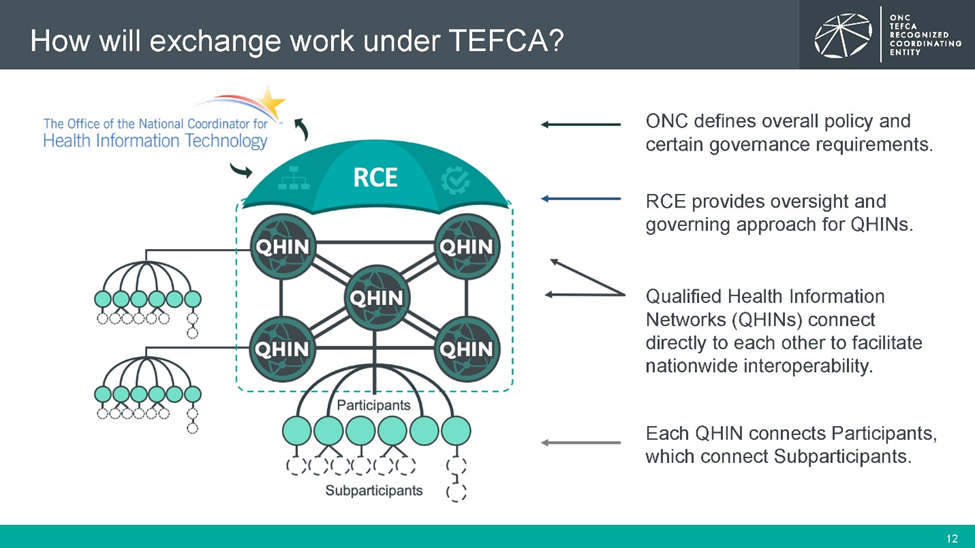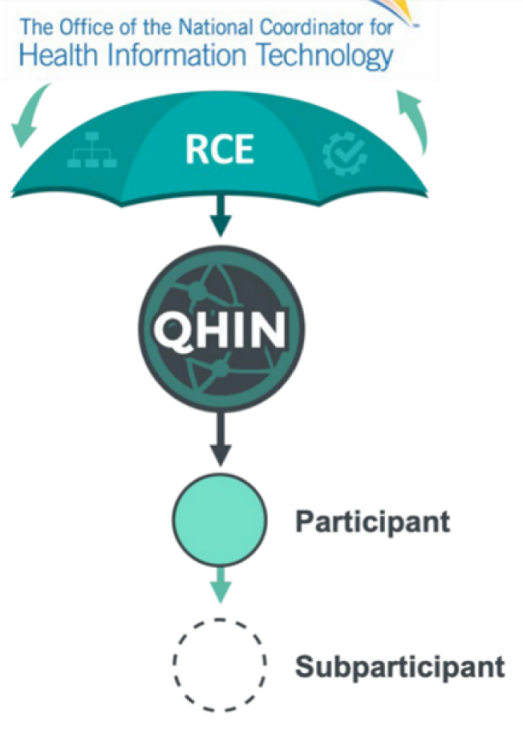TEFCA, Exploring the collaboration with C3HIE, your Health Information Exchange (HIE)
C3HIE, one of the first HIEs in the nation to participate in TEFCA through the eHEalth Exchange’s QHIN
Common Acronyms:
- ONC – Office of the National Coordinator of Health Information Technology
- Participant and Sub-participant – These are U.S. entities that enter into a written agreement with a QHIN, Participant or Sub-participant for TEFCA-based data exchange and fall within one of the categories listed in the RCE SOP: Types of Entities That Can Be a Participant or Sub-participant in TEFCA
- QHIN – Qualified Health Information Network
- QTF – QHIN Technical Framework
- RCE – Recognized Coordinating Entity
- TEFCA – Trusted Exchange Framework and Common Agreement
“eHealth Exchange and C3HIE networks have collaborated for many years,” said Phil Beckett, PhD and CEO of C3HIE. “Joining eHealth Exchange’s anticipated QHIN aligns with C3HIE’s mission to provide our communities with the ability to efficiently and securely send and receive complete clinical information.”
Overview
TEFCA, which stands for the Trusted Exchange Framework and Common Agreement, was mandated by the 21st Century Cures Act of 2016. Congress instructed the U.S. Department of Health and Human Services (HHS) Office of the National Coordinator of Health Information Technology (ONC) to create a comprehensive interoperability framework for the seamless exchange of electronic health information. Interoperability, defined as the capability to share data across diverse technology systems without requiring special user efforts, became a key focus.
In 2019, the ONC appointed the Sequoia Project as the Recognized Coordinating Entity (RCE). This entity is responsible for the development, implementation, and management of TEFCA, serving as the governing body for this nationwide interoperability initiative.
TEFCA comprises four essential elements:
- The Trusted Exchange Framework (TEF)
- The Common Agreement (CA)
- The Qualified Health Information Network Technical Framework (QTF)
- Standard Operating Procedures (SOPs)
On January 19, 2022, the ONC and RCE unveiled the first version of the Trusted Exchange Framework (TEF), Common Agreement, and the Qualified Health Information Network Technical Framework (QTF). Subsequently, the RCE has issued over a dozen finalized and draft Standard Operating Procedures (SOPs), which include guidelines for the onboarding and designation of Qualified Health Information Networks (QHINs). QHINs represent health information networks that satisfy the RCE’s stringent financial, technical, and data governance criteria, forming the essential legal, administrative, and technical infrastructure for nationwide data exchange. The QHIN application process was initiated on October 3, 2022, and the RCE is anticipated to approve the initial set of QHINs in the first quarter of 2023.
Crucially, it is essential to note that the Trusted Exchange Framework (TEF), Common Agreement, Qualified Health Information Network Technical Framework (QTF), and Standard Operating Procedures (SOPs) solely define the guidelines for nationwide data sharing, serving as the regulatory framework.
TEFCA does NOT function as:
- A network
- A technical standards body
- A technology
- A platform
- A data service
- Legally mandated – participation is voluntary.
TEFCA serves as a framework designed to facilitate nationwide data sharing, and its effectiveness hinges on widespread acceptance within the healthcare community. The achievement of its goals relies on the ability of Qualified Health Information Networks (QHINs) and their Participants and Sub-participants to introduce technology and services that adhere to the essential TEFCA requirements.
This article offers an overview of the four pivotal components of TEFCA, highlights distinctions between TEFCA and existing nationwide data sharing frameworks, and outlines Contexture’s strategy for fostering nationwide data sharing within the TEFCA framework.
The Four Elements of TEFCA:
1. The Trusted Exchange Framework
The Framework for Trusted Exchange The component known as the Framework for Trusted Exchange (TEF) consists of seven trust principles that are not legally binding but serve as guiding principles:
- Standardization
- Openness and transparency
- Cooperation and nondiscrimination
- Privacy
- Security and safety
- Access
- Equity and public health
These trust principles influence every aspect of the TEFCA ecosystem, ranging from the Common Agreement and SOPs to the QTF.
2. The Common Agreement
The Common Agreement is a 64-page, legally binding contract established between the Recognized Coordinating Entity (RCE) and approved Qualified Health Information Networks (QHINs). QHINs are obligated to extend numerous provisions of the Common Agreement to their Participants and sub-participants, including adherence to applicable laws and relevant RCE SOPs. Due to these flow-down requirements, the Common Agreement effectively mandates that all individuals and entities participating in the TEFCA ecosystem comply with the same established guidelines when involved in data exchange through a TEFCA-enabled network.

3. The Technical Framework for Qualified Health Information Networks
The Qualified Health Information Network Technical Framework, abbreviated as QTF, along with its associated Technical Trust Requirements, delineates the essential technical criteria that a health information network must fulfill to function as a Qualified Health Information Network (QHIN). As an illustration, QHINs must possess the capability to support two exchange modalities: (1) QHIN Query, which involves a data pull or request from one or more QHINs, and (2) QHIN Message Delivery, which entails a data push to one or more QHINs.
Certain QTF requirements also extend to and influence Participants and sub-participants. For instance, Participants and sub-participants are restricted to being attributed to a single QHIN in the Recognized Coordinating Entity (RCE) Directory. This signifies that a Participant with multiple facilities cannot engage with more than one QHIN.
Additionally, the RCE has outlined a three-year plan for achieving readiness in Fast Healthcare Interoperability Resources (FHIR®). FHIR® is a technical standard that defines data formats and elements (referred to as “resources”) and provides an application programming interface (API) for exchanging health information across different computer systems. FHIR exchange is presently mandated by the CMS interoperability regulations for specific CMS-regulated payers to fulfill Patient Access API requirements. It’s important to note that TEFCA is not anticipated to achieve FHIR readiness until at least 2025.
4. Standard Operating Procedures
QHINs, Participants, and sub-participants are all obligated to adhere to the Recognized Coordinating Entity’s (RCE) Standard Operating Procedures (SOPs) relevant to their roles. These SOPs delineate specific requirements essential for fulfilling obligations outlined in the Common Agreement and QTF, including those obligations that must be extended to Participants and sub-participants. To date, the RCE has introduced and/or finalized more than a dozen SOPs, with ongoing efforts to draft several additional ones.
Each SOP’s title page incorporates an applicability statement specifying the intended recipients of the SOP. For instance, SOP: Exchange Purposes is applicable to QHINs, Participants, and sub-participants. This SOP mandates that all QHINs, Participants, and sub-participants must respond to requests for electronic health information for treatment purposes and individual access services.
C3HIE and TEFCA
We currently provide access to several nationwide data sharing networks, including CareQuality, eHealthExchange, the Patient Centered Data Home, through the Civitas Networks for Health, and CommonWell (indirectly). Additionally, we intend to establish a connection to the forthcoming nationwide TEFCA network exchange, ensuring compliance with legal and regulatory requirements specific to our Texas markets.
What is the Value of a QHIN?
- The 21st Century Cures Act and TEFCA were enacted and designed to streamline healthcare data sharing among providers and patients
- The technical framework and common agreement make it standardized and lower the costs
- QHINs have to meet specific legal and security requirements keeping data safer
- Patient access to their own records is a priority of the law
Why are we joining the eHEX QHIN?
- To be a leader in operability
- To have a seat at the table in designing the future
- To increase individual access requests and empower patients in health information exchange
- Today QHINs are voluntary, but as the network grows and proves its value it is likely to become the primary method for query-based record exchange
What is the value to our customers?
- C3HIE is your knowledgeable partner to help share and educate on the details of QHINs
- An easy on ramp – no additional connections or costs or work, just accept the flow down requirements
- Your patients travel, make it easier to share their records across the country in a secure and standardized format.
What does C3HIE’s participation in TEFCA entail for our Participants?
New TEFCA Service Line: Similar to how our customers currently choose and use HIE services, C3HIE plans to establish a new TEFCA service line. Upon formalizing a contract with a Qualified Health Information Network (QHIN), we will assess existing interface connections that may be utilized to support data exchange.
- Opt-In Model: C3HIE customers will have the option to “Opt-In” to C3HIE’s QHIN connection. Those choosing to opt-in will become Sub-participants in C3HIE’s QHIN Connection.
- Addendum to HIE Participation Agreement: Customers opting to be Sub-participants through C3HIE will need to sign an addendum to their HIE Participation Agreement. This addendum will incorporate a set of mandatory flow-down requirements from the Common Agreement and from C3HIE’s chosen QHIN. C3HIE intends to price its TEFCA Service Line in alignment with other HIE services, ensuring competitive rates.
- Timeline for TEFCA Network Connection: The initiation of HIE data sharing through a TEFCA connection is uncertain.

What is the Value of a QHIN?
Incorporating a TEFCA connection into C3HIE’s existing service portfolio will amplify the value of our Health Information Exchange (HIE) by providing participants with a gateway to a nationally recognized, federally endorsed network. Accessing a potential TEFCA network through C3HIE offers several advantages:
- Affordability: C3HIE’s TEFCA connection may present a more cost-effective and economical option compared to direct Qualified Health Information Network (QHIN) participation (e.g., through an Electronic Health Record vendor connection) or other Participant connections.
- Local Governance Structure: C3HIE operates with a local governance structure that upholds downstream permitted uses validated and approved by the Texas communities.
- Focus on Equity: C3HIE is dedicated to ensuring that all providers in Texas have equal opportunities to participate in TEFCA and access the necessary data for their patients.
- Advanced Patient Matching/Identity Resolution Ability: HIEs like C3HIE already possess advanced patient matching capabilities, providing added value to Sub-participants.
- Access to Other Networks and Connections: C3HIE currently provides access to various national data sharing networks, including eHealth Exchange, CareQuality, Patient-Centered Data Home (PCDH) and other HIE-to-HIE connections, as well as state/local public health connections beyond TEFCA.
